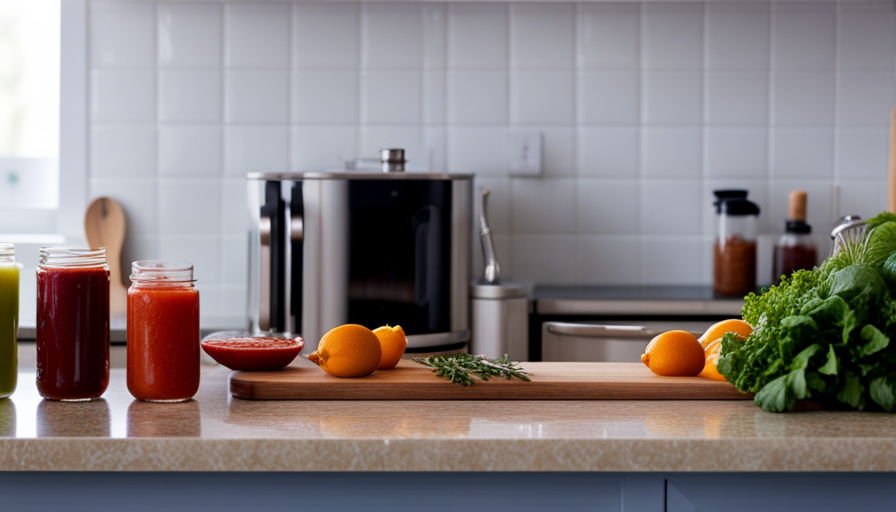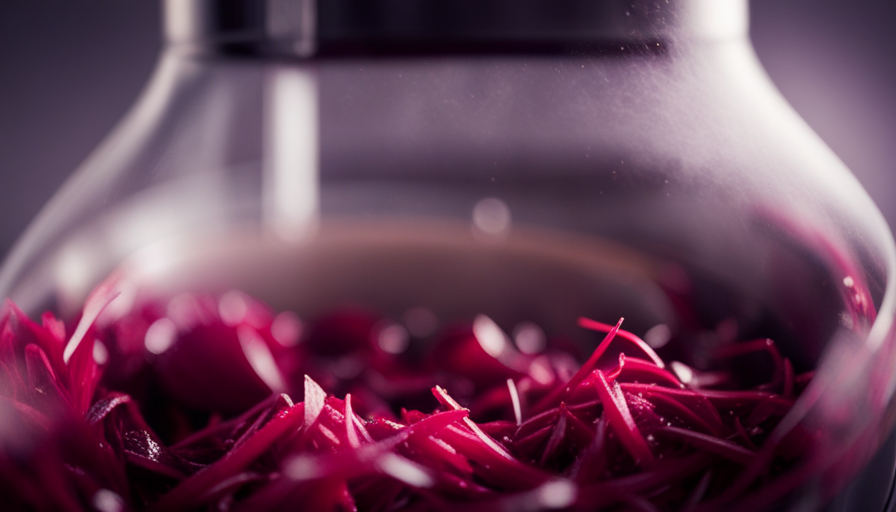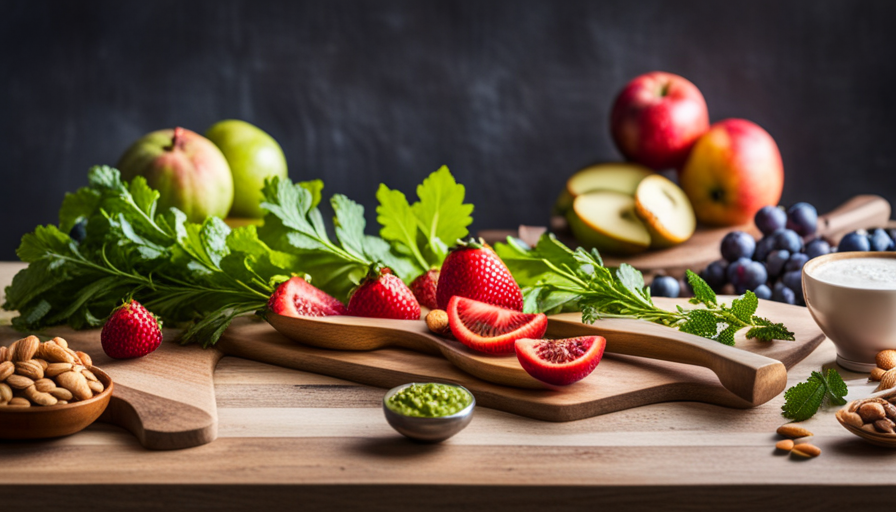Are you feeling tired and weighed down by processed foods? Do you want to transition to a healthier eating routine but unsure where to start? While the concept of starting a raw food diet may seem daunting, with the right guidance and approach, it can be a gradual and rewarding experience.
You may be thinking, ‘But isn’t it difficult to detox and switch to a raw food diet?’ While it’s true that detoxing can be challenging, this article will provide you with practical steps to make the transition easier. By understanding the benefits of a raw food diet, setting realistic goals, making small changes in your diet, incorporating fresh fruits and vegetables, exploring different raw food recipes, boosting nutrient intake with superfoods, staying hydrated, and seeking support from raw food communities, you can gradually detox and embrace a raw food lifestyle.
Get ready to revitalize your body and experience the vibrant benefits of a raw food diet.
Key Takeaways
- Start with small changes in your diet to gradually transition into a raw food diet.
- Incorporate more fruits and vegetables into your meals.
- Gradually replace cooked foods with raw alternatives.
- Plan your meals ahead of time and shop for organic fruits and vegetables, raw nuts, and seeds.
Understanding the Benefits of a Raw Food Diet
You won’t believe how amazing you’ll feel when you switch to a raw food diet and start reaping the incredible benefits! Understanding the science behind a raw food diet can help you make an informed decision about transitioning into this lifestyle.
Raw food enthusiasts believe that cooking destroys essential enzymes and nutrients in food, which can lead to various health issues. By consuming raw fruits, vegetables, nuts, and seeds, you’re providing your body with a rich source of vitamins, minerals, and antioxidants that can boost your immune system and support overall well-being.
Exploring potential risks associated with a raw food diet is also important. While there are numerous benefits, it’s essential to be aware of potential challenges. One of the main concerns is meeting all your nutritional needs. Raw food diets may lack certain nutrients like vitamin B12, iron, and omega-3 fatty acids, which are typically found in animal products. Therefore, it’s crucial to plan your meals carefully and consider supplementation if necessary.
Additionally, raw food diets can be challenging to sustain in the long term, as they require careful planning, preparation, and dedication. It’s important to ensure that you’re getting enough calories and variety in your diet to avoid nutrient deficiencies. Consulting a healthcare professional or a registered dietitian can provide you with personalized guidance and ensure that you’re meeting all your nutritional requirements while enjoying the benefits of a raw food diet.
Setting Realistic Goals for Your Transition
Start by taking small steps and allowing yourself to ease into a new way of nourishing your body, like dipping your toes into a refreshing pool on a scorching summer day. Setting realistic goals for your transition to a raw food diet is essential to ensure long-term success. It’s important to have realistic expectations and understand that progress may be slow, but every step forward is a step in the right direction.
To help you set realistic goals, consider using a table to track your progress. This visual representation can evoke emotion and motivate you to stay on track. Here’s an example:
| Goal | Action | Progress |
|---|---|---|
| Increase raw food intake | Start by adding one raw meal a day | Week 1 – 3 raw meals |
| Eliminate processed foods | Gradually replace processed snacks | Week 2 – No processed snacks |
| Experiment with new recipes | Try one new raw recipe each week | Week 3 – Successfully made a new recipe |
Remember, slow progress is still progress. Don’t beat yourself up if you have setbacks or find it challenging to stick to your goals. It’s normal to have ups and downs during any lifestyle change. The key is to stay committed and motivated, and celebrate each small victory along the way. With time, patience, and realistic expectations, you’ll gradually transition to a raw food diet and experience the incredible benefits it can bring to your health and well-being.
Starting with Small Changes in Your Diet
Dipping your toes into a refreshing pool on a scorching summer day, it’s all about taking small steps and making enjoyable changes in your eating habits. When it comes to transitioning into a raw food diet, starting with small changes in your diet is the key to success.
Instead of completely overhauling your entire diet overnight, it’s important to gradually introduce raw foods into your meals. One simple way to start is by incorporating more fruits and vegetables into your daily meals. For example, you can begin by adding a side of fresh fruit to your breakfast or replacing your usual afternoon snack with a handful of raw nuts or carrots. These small changes not only introduce more raw foods into your diet but also provide you with essential nutrients and fiber.
Another effective strategy is to gradually replace cooked foods with raw alternatives. For instance, you can try swapping out your regular pasta noodles with zucchini noodles or replacing your cooked rice with cauliflower rice. These substitutions not only add more raw foods to your diet but also help you explore new flavors and textures.
Remember, a gradual transition allows your body to adapt to the changes and makes the process more sustainable in the long run. So, take it one step at a time, enjoy the process, and savor the deliciousness of raw foods as you embark on your journey towards a healthier lifestyle.
Incorporating More Fresh Fruits and Vegetables
Indulge in the vibrant colors and juicy flavors of an assortment of fresh fruits and vegetables, transforming your meals into a feast for both the eyes and taste buds. As you gradually detox into a raw food diet, one of the key steps is to incorporate more fresh fruits and vegetables into your meals. These powerful plant-based foods are packed with essential vitamins, minerals, and antioxidants that can help boost your overall health and wellbeing.
To increase your raw food consumption, start by adding a variety of fruits and vegetables to your daily meals. You can enjoy a refreshing fruit salad for breakfast or snack on sliced cucumbers and cherry tomatoes throughout the day. Experiment with different combinations to find what you enjoy the most.
Another great way to incorporate more plant-based meals is by trying out raw food recipes. There are countless delicious and nutritious options available, from zucchini noodles with pesto sauce to raw vegan sushi rolls. These dishes not only provide you with the nutrients you need, but they also offer a unique and exciting culinary experience.
Remember, the key to successfully transitioning to a raw food diet is to take it one step at a time. Gradually increase your intake of fresh fruits and vegetables, and explore new recipes and flavors along the way. By incorporating more plant-based meals into your diet, you’ll be well on your way to experiencing the numerous benefits of a raw food lifestyle.
Exploring Different Raw Food Recipes
Get ready to embark on a culinary adventure as you dive into a world of vibrant flavors and creative combinations with different raw food recipes that’ll awaken your taste buds like a symphony of flavors.
Exploring different raw food recipes not only adds variety to your diet but also helps you discover new ways to enjoy the benefits of a raw food lifestyle.
Here are three important aspects to consider when venturing into this exciting realm:
-
Meal Planning: When exploring raw food recipes, it’s important to plan your meals ahead of time. This ensures that you have all the necessary ingredients on hand and helps you stay on track with your raw food diet. Consider incorporating a variety of fruits, vegetables, nuts, and seeds to create balanced and nutritious meals.
-
Grocery Shopping: To successfully explore different raw food recipes, it’s essential to stock up on fresh and high-quality ingredients. Make a list before heading to the grocery store, including items such as organic fruits and vegetables, raw nuts and seeds, and superfoods like spirulina or chia seeds. Shopping for raw food ingredients can be an exciting experience as you discover new produce and gather the building blocks for delicious meals.
-
Recipe Exploration: Experiment with different raw food recipes to find your favorites. Start with simple recipes like smoothies, salads, or zucchini noodles and gradually expand your repertoire as you gain confidence. Raw food recipes often involve blending, dehydrating, or marinating techniques to enhance flavors and textures. Be open to trying new flavor combinations and techniques to truly enjoy the diverse world of raw food.
By exploring different raw food recipes, planning meals, and shopping for quality ingredients, you can gradually detox into a raw food diet while indulging in delicious and nutritious dishes. So, put on your chef’s hat and let your taste buds guide you on this exciting journey to optimal health.
Gradually Eliminating Processed Foods
Take a leap towards a healthier you by slowly eliminating processed foods from your daily meals, allowing your body to thrive on nourishing, whole ingredients. Transitioning gradually is key to making lasting changes to your diet.
Processed foods are often loaded with unhealthy additives, preservatives, and excess sugar, which can wreak havoc on your health over time. By gradually eliminating these foods, you give your body a chance to adjust and start craving healthier options.
Start by identifying the processed foods in your diet and finding healthier alternatives. For example, swap out sugary cereals for whole grain oatmeal or homemade granola. Replace pre-packaged snacks with fresh fruits, vegetables, and homemade trail mix. Gradually reduce your intake of sugary drinks and replace them with water, herbal teas, or freshly squeezed juices.
Focus on cooking more meals at home using whole, unprocessed ingredients. Experiment with different herbs, spices, and cooking techniques to enhance the flavors of your meals. By preparing your own meals, you have control over the quality of ingredients and can avoid hidden additives.
Remember, transitioning to a raw food diet doesn’t mean you have to eliminate all processed foods at once. Take it one step at a time and be patient with yourself. Celebrate your small victories along the way and embrace the journey towards a healthier, more vibrant you.
Boosting Your Nutrient Intake with Superfoods
Enhance your well-being by incorporating nutrient-rich superfoods into your daily meals, allowing your body to thrive on their vibrant colors and powerful health benefits. Superfoods are packed with essential vitamins, minerals, and antioxidants that can help boost your energy levels and improve digestion.
One superfood that can provide a significant energy boost is maca. This root vegetable, native to Peru, is known for its ability to increase stamina and endurance. Add a teaspoon of maca powder to your smoothies or sprinkle it on top of your morning oatmeal for an extra kick of energy.
Another superfood to consider is chia seeds. These tiny seeds are packed with omega-3 fatty acids, fiber, and protein, making them an excellent addition to any meal. They can help improve digestion by promoting regular bowel movements and reducing inflammation in the gut. Try adding a tablespoon of chia seeds to your yogurt or mixing them into your favorite salad dressing.
Lastly, don’t forget about leafy greens like kale and spinach. These nutrient powerhouses are rich in vitamins A, C, and K, as well as iron and calcium. They can help boost energy levels and improve digestion by providing essential nutrients and promoting a healthy gut. Incorporate them into your meals by adding them to salads, smoothies, or sautéing them as a side dish.
By incorporating these nutrient-rich superfoods into your diet, you can boost your energy levels and improve digestion, leading to overall improved well-being.
Staying Hydrated and Incorporating Raw Juices
Quench your thirst and nourish your body by incorporating refreshing raw juices into your daily routine. Staying hydrated is essential for overall health and well-being. Raw juices are a fantastic way to hydrate your body and provide it with an abundance of nutrients.
Here are some practical hydration tips and the benefits of adding raw juices to your diet:
-
Hydration tips: Drink plenty of water throughout the day to stay hydrated. Set reminders or carry a water bottle with you to ensure you’re getting enough fluids. Avoid sugary drinks that can dehydrate you, and opt for natural options like fruit-infused water or herbal teas.
-
Boosts nutrient intake: Raw juices are packed with vitamins, minerals, and antioxidants that are easily absorbed by your body. They can help strengthen your immune system, improve digestion, and give you a natural energy boost.
-
Promotes detoxification: Raw juices are an excellent way to support your body’s natural detoxification process. They help flush out toxins, improve liver function, and promote healthy skin.
-
Improves digestion: Raw juices contain enzymes that aid digestion and promote a healthy gut. They can help alleviate bloating, constipation, and other digestive issues.
-
Provides hydration: Raw juices are a great source of hydration as they contain a high water content. They can help replenish electrolytes, especially after exercise or during hot weather.
Incorporating raw juices into your daily routine is a simple and delicious way to stay hydrated and boost your nutrient intake. Cheers to a healthier you!
Listening to Your Body’s Needs during the Transition
Pay attention to the signals your body’s sending you during this transition period; it’s like a symphony of whispers guiding you towards what it truly needs.
As you gradually detox into a raw food diet, it’s important to listen to your body’s signals and practice intuitive eating. Your body knows best what it needs, and by paying attention to its cues, you can make informed decisions about what foods to consume.
During the transition, you may experience cravings or feelings of hunger. This is normal as your body adjusts to the new diet. Take the time to assess whether your cravings are genuine hunger or simply a habit or emotional response. If you’re truly hungry, choose raw foods that are rich in nutrients and satisfy your body’s needs.
Additionally, be aware of any changes in your energy levels, digestion, and overall well-being. These can be indicators of whether the raw food diet is working for you or if adjustments need to be made. If you experience any discomfort or adverse effects, consider consulting with a healthcare professional or a nutritionist who specializes in raw food diets.
Remember that each person’s body is unique, so it’s important to listen to your own body’s signals and make adjustments accordingly. Trust yourself and your intuition when it comes to nourishing your body with raw foods.
Seeking Support and Guidance from Raw Food Communities
Finding support and guidance from raw food communities can be a transformative and empowering experience. When transitioning to a raw food diet, it’s essential to connect with others who share your goals and can offer valuable insights.
Here are three ways raw food support groups and mentors can assist you on your journey:
-
Raw food support groups: Joining a raw food support group can provide you with a sense of community and belonging. These groups often organize regular meetups, where you can share your experiences, learn from others, and exchange recipes and tips. Being part of a supportive community can help you stay motivated and inspired on your raw food journey.
-
Finding raw food mentors: Seeking guidance from experienced raw food mentors can greatly accelerate your transition. Mentors can offer personalized advice, answer your questions, and provide you with practical strategies for success. They can share their own experiences, offer emotional support, and help you overcome any challenges you may encounter.
-
Online resources and forums: In addition to local support groups and mentors, there are numerous online resources and forums dedicated to raw food diets. These platforms provide a wealth of information, including recipes, meal plans, and success stories. Engaging with these communities can give you access to a global network of like-minded individuals who can offer guidance and encouragement.
By connecting with raw food support groups and mentors, you can tap into a wealth of knowledge and support that’ll make your transition to a raw food diet more manageable and enjoyable.
Frequently Asked Questions
Are there any potential risks or side effects of transitioning to a raw food diet?
Transitioning to a raw food diet can come with potential health risks and common challenges. Some potential health risks include nutrient deficiencies, especially in vitamins B12, D, and iron. It may also lead to weight loss, digestive issues, and difficulty meeting calorie needs.
Common challenges include cravings for cooked foods, social isolation, and the need for careful meal planning. It’s important to consult with a healthcare professional and gradually make the switch to minimize these risks and challenges.
Can I still get all the necessary nutrients and protein on a raw food diet?
Yes, you can still get all the necessary nutrients and protein on a raw food diet. While it may require some planning, there are plenty of plant-based sources that provide the protein your body needs. These include nuts, seeds, legumes, and leafy greens. Additionally, by incorporating a variety of fruits and vegetables into your diet, you can ensure you’re getting all the necessary nutrients your body requires for optimal health.
How can I deal with cravings for processed foods during the transition?
To manage cravings for processed foods during the transition to a raw food diet, there are a few strategies you can try.
First, identify the root causes of your cravings, such as emotional triggers or habits.
Then, find healthy alternatives that satisfy those cravings, like raw nuts or homemade vegetable chips.
Additionally, make sure you’re eating a variety of nutrient-dense foods on your raw food diet to minimize nutrient deficiencies.
Gradually reducing processed foods and incorporating more raw options can make the transition easier.
Is it necessary to buy expensive equipment like a dehydrator or juicer to follow a raw food diet?
You don’t need to break the bank to follow a raw food diet. There are cost-effective alternatives to expensive equipment like dehydrators and juicers.
Instead of a dehydrator, you can use your oven on its lowest setting or even the sun to dry fruits and vegetables. As for juicing, a blender can work just as well.
To successfully transition to a raw food diet without specialized equipment, focus on incorporating more whole, fresh fruits, vegetables, nuts, and seeds into your meals.
What should I do if I experience digestive issues or changes in bowel movements during the transition?
If you experience digestive issues or changes in bowel movements during the transition to a raw food diet, there are a few things you can do. Firstly, make sure you’re drinking enough water to stay hydrated.
Secondly, gradually increase your intake of raw fruits and vegetables to allow your digestive system to adjust.
Lastly, consider adding probiotic-rich foods like sauerkraut or kombucha to help support a healthy gut. If your symptoms persist, it’s always a good idea to consult with a healthcare professional.
Can I Detox into a Raw Food Diet Gradually Before Doing a Raw Food Cleanse?
Yes, it is possible to transition gradually into a raw food diet before fully committing to a raw food cleanse process. Starting by incorporating more raw fruits, vegetables, and nuts into your meals can help your body adjust to the new diet over time, making the cleanse process easier.
Can Gradually Detoxing into Raw Food Diet Help Reset My Metabolism?
Yes, gradually transitioning to a raw food diet can definitely help reset your metabolism. Raw foods are rich in enzymes and nutrients that can aid in digestion and boost metabolism. By incorporating more raw foods into your diet, you can reset your metabolism and improve overall health.
Conclusion
In conclusion, embracing a raw food diet can bring numerous benefits for your overall health and well-being. By gradually detoxing into this lifestyle, you can experience increased energy, improved digestion, and enhanced immune function.
Remember to set realistic goals, start small, and incorporate a variety of fresh fruits, vegetables, and superfoods into your diet. Stay hydrated with raw juices and listen to your body’s needs throughout the transition.
Seek support and guidance from raw food communities to ensure a successful and enjoyable journey towards optimal health. Take the first step towards a vibrant and nourishing life!










